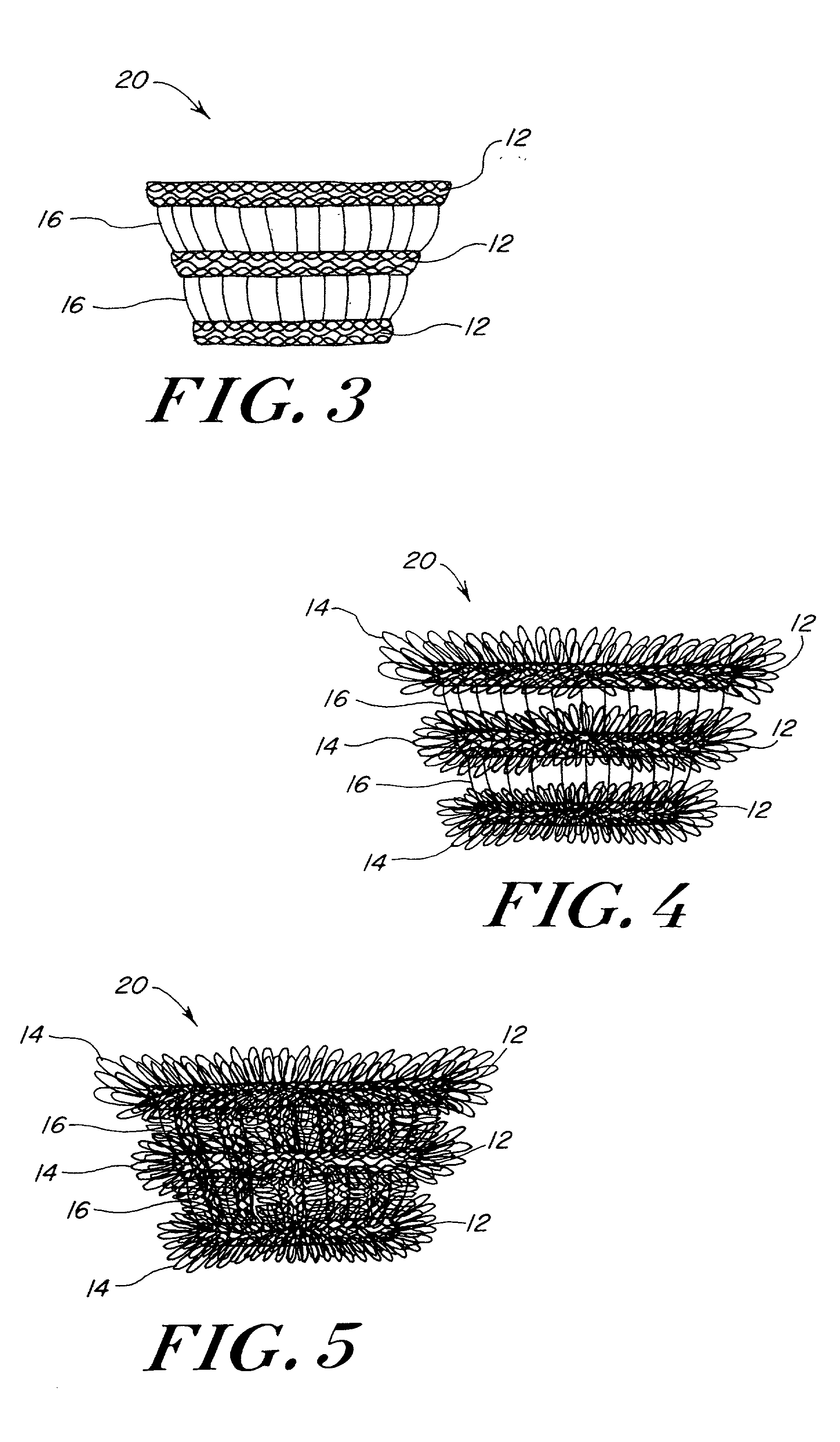[0008] There exists in the art a need for a biocompatible surgical
implantable prosthesis suitable for repairing, stabilizing, anchoring more completely, and filling of both naturally occlusive tissue defects, or open holes from trauma or
cancer, while effectively promoting rapid tissue in-growth with less structural or
material density. A more dense or less porous fabric results in a more pronounced
foreign body reaction to the implant. The implant construction of the present invention provides more structural contact filling of a tissue hole or defect, with a more open and resilient 3-dimensional structure that enables quick healing, with a lower density and
resultant tissue encapsulation.
[0009] A biocompatible soft tissue implant provided in accordance with one example embodiment of the present invention is a
pile mesh
prosthesis constructed of a plurality of strips of knitted pile mesh, interconnected by one or more monofilament connecting bridges. At least one row has a plurality of filament extensions projecting outwardly therefrom. The filament extensions, in accordance with one aspect of the present invention, are in the form of a plurality of filament loops that provide radial contact with tissue to stabilize the implant and provide resistance to compression or crushing forces applied to the
prosthesis following implantation. Structurally, the rows of knitted pile mesh provide
mechanical strength, compliance, and flexibility. The protruding loops, which extend radially from the rows, provide a structural tissue contact means minimizing direct contact of the knitted rows of mesh, thereby reducing the density of material to be healed after implant. The rows can be of a different foundational structure for supporting the filament extensions.
[0010] The pile mesh construction can fit into an irregularly shaped tissue hole or defect and completely fill the area as a material plug, with significantly less material
mass than a traditional flat mesh fabric or patch. Such an open pile mesh prosthesis provides a relatively lighter, less dense, structural hole filler facilitating more rapid healing.
Biomaterial evidence indicates that less plastic results in less
inflammation, and less
mass requires less
cell remodeling to achieve full tissue stabilization and prevent encapsulation. The pile mesh prosthesis of the present invention, due to its 3-dimensional filament configuration, also helps to stabilize the implant in a more fixed, less likely to migrate, condition relative to current known flat mesh fabric devices. The overall
radial compression resistance of the loop filament extensions, together with the multiple rows of the knitted mesh, provides a more uniformly fitting prosthesis for a preferred tension free prosthetic repair. The inventive device requires less orientation by the surgeon during placement because of the self-centering action of the radially protruding loops.
[0011] Aspects of the present invention provide unique tissue contact for healing and stabilization without the need for excessive laminations or flat material bulk. The pile mesh prosthesis device employs relatively less material bulk, or
mass, and maintains good contact surface geometric area. The pile mesh prosthesis can further have an organized 3-dimensional structure that can provide a relatively large external dimensional volume, with a relatively small weight, or amount, of plastic. The pile mesh structure is a relatively elastic structure having a plurality of structural elements forming an interior thereof. The structure is substantially compressible, while maintaining a shape memory. The overall structure is lighter than equivalently sized and shaped flat mesh fabric constructions.
[0014] The biocompatible implant, in accordance with still another aspect of the present invention, has the pile mesh material permanently arranged in a 3-dimensional shape or structure, such as, e.g., a tube,
pyramid, or hexagon, suitable for conforming to a specific
tissue defect anomaly. A gathering of the rows of loop mesh arranged within a 3-dimensional structure shape or structure can also provide additional radial support structure, without adding mass to the implant.
 Login to View More
Login to View More  Login to View More
Login to View More 


